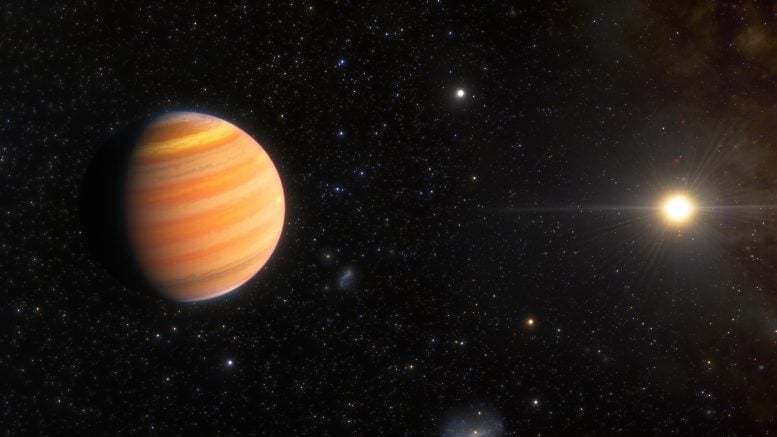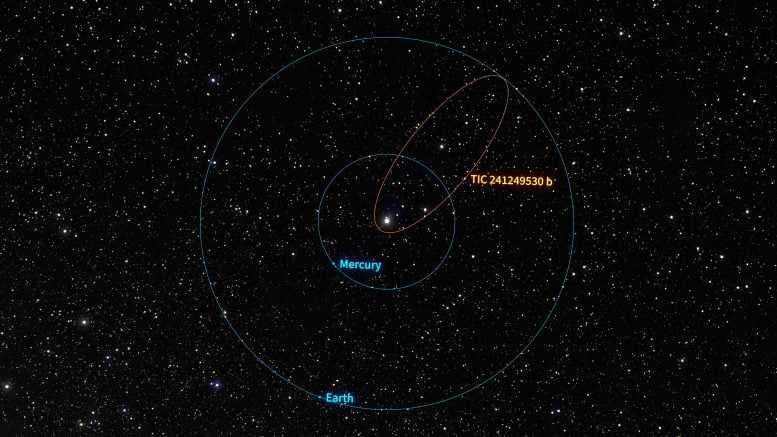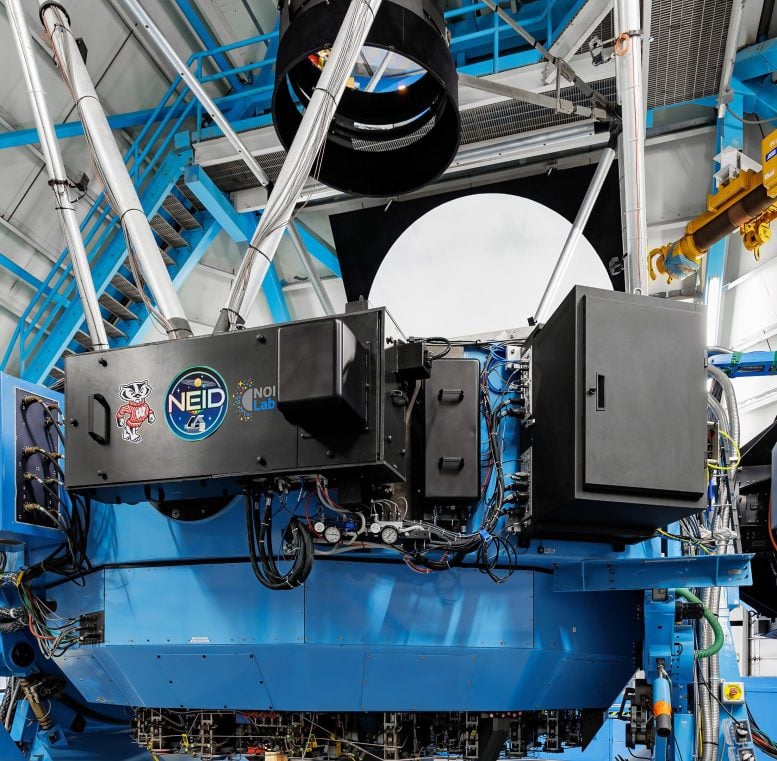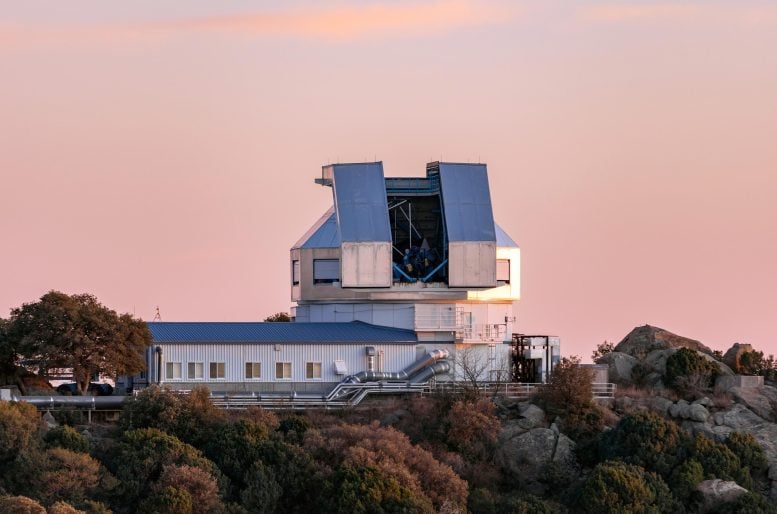
This artist’s impression shows a Jupiter-like exoplanet that is on its way to becoming a hot Jupiter — a large, Jupiter-like exoplanet that orbits very close to its star. Using the WIYN 3.5-meter telescope at the U.S. National Science Foundation Kitt Peak National Observatory, a Program of NSF NOIRLab, a team of astronomers found that this exoplanet, named TIC 241249530 b, follows an extremely elliptical orbit in the direction opposite to the rotation of its host star. These unique orbital characteristics hint at the planet’s formation history as well as its future trajectory, allowing the team to determine that TIC 241249530 b will eventually migrate inward to a tighter, more circular orbit. Discovering this exoplanet pre-migration lends valuable insight into how hot Jupiters form and evolve over time. Credit: NOIRLab/NSF/AURA/J. da Silva (Spaceengine)
An exoplanet’s elongated, backwards orbit holds clues to the formation history and future trajectories of high-mass gas giants.
Astronomers have observed an exoplanet with a highly eccentric and retrograde orbit using the WIYN telescope. This exoplanet, named TIC 241249530 b, could significantly advance our understanding of the formation and migration of hot Jupiters, which are typically larger gas giants that migrate to very close orbits around their stars.
Discovery of an Exoplanet With Extreme Orbit
Using the WIYN 3.5-meter telescope at the U.S. National Science Foundation Kitt Peak National Observatory, a Program of NSF NOIRLab, astronomers have discovered the extreme orbit of an exoplanet that’s on its way to becoming a hot Jupiter. This exoplanet not only follows one of the most drastically stretched-out orbits of all known transiting exoplanets but is also orbiting its star backward, lending insight into the mystery of how hot Jupiters evolve.
At present, there are over 5,600 confirmed exoplanets in just over 4,000 star systems. Within this population, about 300–500 exoplanets fall into the curious class known as hot Jupiters — large, Jupiter-like exoplanets that orbit very close to their star, some even as close as Mercury is to our Sun. How hot Jupiters end up in such close orbits is a mystery, but astronomers postulate that they begin in orbits far from their star and then migrate inward over time. The early stages of this process have rarely been observed, but with this new analysis of an exoplanet with an unusual orbit, astronomers are one step closer to unraveling the hot Jupiter mystery.
Advanced Observational Techniques and Findings
The discovery of this exoplanet, named TIC 241249530 b, originated with the detection by NASA’s Transiting Exoplanet Survey Satellite (TESS) in January 2020 of a dip in a star’s brightness consistent with a single Jupiter-sized planet passing in front of, or transiting, it. To confirm the nature of these fluctuations and eliminate other possible causes, a team of astronomers used two instruments on the WIYN 3.5-meter Telescope at the U.S. National Science Foundation Kitt Peak National Observatory (KPNO), a Program of NSF NOIRLab.
The team first utilized the NASA-funded NN-EXPLORE Exoplanet and Stellar Speckle Imager (NESSI) in a technique that helps to ‘freeze out’ atmospheric twinkling and eliminate any extraneous sources that might confuse the signal’s source. Then, using the NASA-funded NEID spectrograph, the team measured the radial velocity of TIC 241249530 b by carefully observing how its host star’s spectrum, or wavelengths of its emitted light, shifted as a result of the exoplanet orbiting it.

This illustration shows the orbit of the newly discovered Jupiter-like exoplanet named TIC 241249530 b, shown in comparison to the orbits of Mercury and Earth in our own Solar System. TIC 241249530 b follows one of the most stretched-out orbits of any transiting exoplanet known and also orbits its host star backwards, meaning in the direction opposite the star’s rotation. Credit: NOIRLab/NSF/AURA/R. Proctor
Arvind Gupta, NOIRLab postdoctoral researcher and lead author of the paper published in Nature, praised NESSI and NEID as being critical to the team’s efforts to characterize and confirm the exoplanet’s signal. “NESSI gave us a sharper view of the star than would have been possible otherwise, and NEID precisely measured the star’s spectrum to detect shifts in response to the orbiting exoplanet,” explained Gupta. Gupta particularly noted the unique flexibility of NEID’s observation-scheduling framework as it allows for swift adaptation of the team’s observing plan in response to new data.
“The WIYN telescope is playing a crucial role in helping us understand why the planets found in other solar systems can be so different from system to system,” said NSF’s Chris Davis, program director for NSF NOIRLab. “The collaboration between NSF and NASA on the NN-EXPLORE program continues to yield impressive results in exoplanet research.”
This animation shows the orbit of the newly discovered Jupiter-like exoplanet named TIC 241249530 b, shown in comparison to the orbits of Mercury and Earth in our own Solar System. TIC 241249530 b follows one of the most stretched-out orbits of any transiting exoplanet known and also orbits its host star backward, meaning in the direction opposite the star’s rotation. If this planet was part of our Solar System its orbit would stretch from its closest approach ten times closer to the Sun than Mercury all the way out to its most distant extent at Earth’s distance. This extreme orbit would cause temperatures on the planet to vary between that of a summer’s day to hot enough to melt titanium. Credit: NOIRLab/NSF/AURA/R. Proctor
Implications of Eccentric and Retrograde Orbits
Detailed analysis of the spectrum confirmed that the exoplanet is approximately five times more massive than Jupiter. The spectrum also revealed that the exoplanet is orbiting along an extremely eccentric, or stretched-out, path. The eccentricity of a planet’s orbit is measured on a scale from 0 to 1, with 0 being a perfectly circular orbit and 1 being highly elliptical. This exoplanet has an orbital eccentricity of 0.94, making it more eccentric than the orbit of any other exoplanet ever found via the transiting method [1]. For comparison, Pluto’s highly elliptical orbit around the Sun has an eccentricity of 0.25; Earth’s eccentricity is 0.02.
If this planet was part of our Solar System its orbit would stretch from its closest approach ten times closer to the Sun than Mercury all the way out to its most distant extent at Earth’s distance. This extreme orbit would cause temperatures on the planet to vary between that of a summer’s day to hot enough to melt titanium.

The interior of the WIYN 3.5-meter Telescope, located at the U.S. National Science Foundation Kitt Peak National Observatory, a Program of NSF NOIRLab. This telescope hosts the NEID instrument, which is a state-of-the-art exoplanet-discovery machine. Credit: KPNO/NOIRLab/NSF/AURA/J.Pollard
To add to the unusual nature of the exoplanet’s orbit, the team also found that it’s orbiting backwards, meaning in a direction opposite to the rotation of its host star. This is not something that astronomers see in most other exoplanets, nor in our own Solar System, and it helps inform the team’s interpretation of the exoplanet’s formation history.
The exoplanet’s unique orbital characteristics also hint at its future trajectory. It’s expected that its initial highly eccentric orbit and extremely close approach to its host star will ‘circularize’ the planet’s orbit, since tidal forces on the planet sap energy from the orbit and cause it to gradually shrink and circularize. Discovering this exoplanet before this migration has taken place is valuable as it lends crucial insight into how hot Jupiters form, stabilize, and evolve over time.
“While we can’t exactly press rewind and watch the process of planetary migration in real time, this exoplanet serves as a sort of snapshot of the migration process,” Gupta said. “Planets like this are incredibly rare and hard to find, and we hope it can help us unravel the hot Jupiter formation story.”

The WIYN 3.5-meter Telescope, located at the U.S. National Science Foundation Kitt Peak National Observatory, a Program of NSF NOIRLab. Credit: KPNO/NOIRLab/NSF/AURA
Future Prospects and Research Directions
“We’re especially interested in what we can learn about the dynamics of this planet’s atmosphere after it makes one of its scorchingly close passages to its star,” said Jason Wright, Penn State professor of astronomy and astrophysics who supervised the project while Gupta was a doctoral student at the university. “Telescopes like NASA’s James Webb Space Telescope have the sensitivity to probe the changes in the atmosphere of the newly discovered exoplanet as it undergoes rapid heating, so there is still much more for the team to learn about the exoplanet.”
TIC 241249530 b is only the second exoplanet ever discovered to demonstrate the hot Jupiter pre-migration phase. Together, these two examples observationally affirm the idea that higher-mass gas giants evolve to become hot Jupiters as they migrate from highly eccentric orbits toward tighter, more circular orbits.
“Astronomers have been searching for exoplanets that are likely precursors to hot Jupiters, or that are intermediate products of the migration process, for more than two decades, so I was very surprised — and excited — to find one,” Gupta said. “It’s exactly what I was hoping to find.”
Notes
- One exoplanet has been found with a higher eccentricity. HD 20782 b has an eccentricity of 0.956 but is not transiting, thus the orientation of its orbit compared to its host star cannot be determined. This emphasizes the importance of the discovery of TIC 241249530 b whose orbital characteristics could be determined thanks to its transiting its star.
Reference: “A hot-Jupiter progenitor on a super-eccentric retrograde orbit” by Arvind F. Gupta, Sarah C. Millholland, Haedam Im, Jiayin Dong, Jonathan M. Jackson, Ilaria Carleo, Jessica Libby-Roberts, Megan Delamer, Mark R. Giovinazzi, Andrea S. J. Lin, Shubham Kanodia, Xian-Yu Wang, Keivan Stassun, Thomas Masseron, Diana Dragomir, Suvrath Mahadevan, Jason Wright, Jaime A. Alvarado-Montes, Chad Bender, Cullen H. Blake, Douglas Caldwell, Caleb I. Cañas, William D. Cochran, Paul Dalba, Mark E. Everett, Pipa Fernandez, Eli Golub, Bruno Guillet, Samuel Halverson, Leslie Hebb, Jesus Higuera, Chelsea X. Huang, Jessica Klusmeyer, Rachel Knight, Liouba Leroux, Sarah E. Logsdon, Margaret Loose, Michael W. McElwain, Andrew Monson, Joe P. Ninan, Grzegorz Nowak, Enric Palle, Yatrik Patel, Joshua Pepper, Michael Primm, Jayadev Rajagopal, Paul Robertson, Arpita Roy, Donald P. Schneider, Christian Schwab, Heidi Schweiker, Lauren Sgro, Masao Shimizu, Georges Simard, Guðmundur Stefánsson, Daniel J. Stevens, Steven Villanueva, John Wisniewski, Stefan Will and Carl Ziegler, 17 July 2024, Nature.
DOI: 10.1038/s41586-024-07688-3








Be the first to comment on "Breaking the Rules: Rare Exoplanet’s Extremely Strange Orbit Stuns Astronomers"